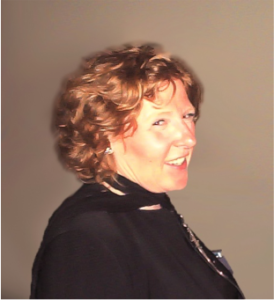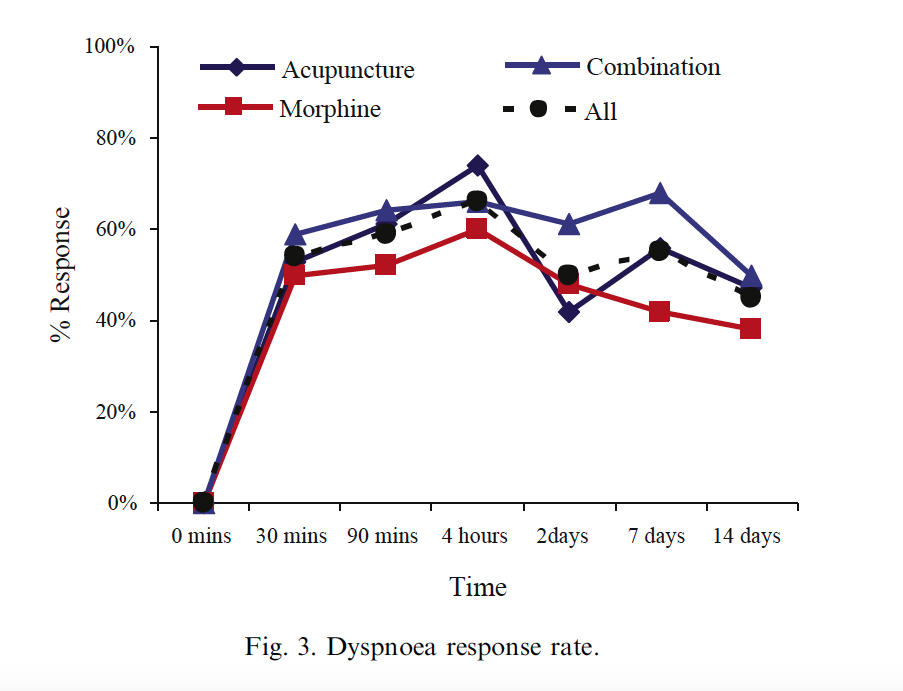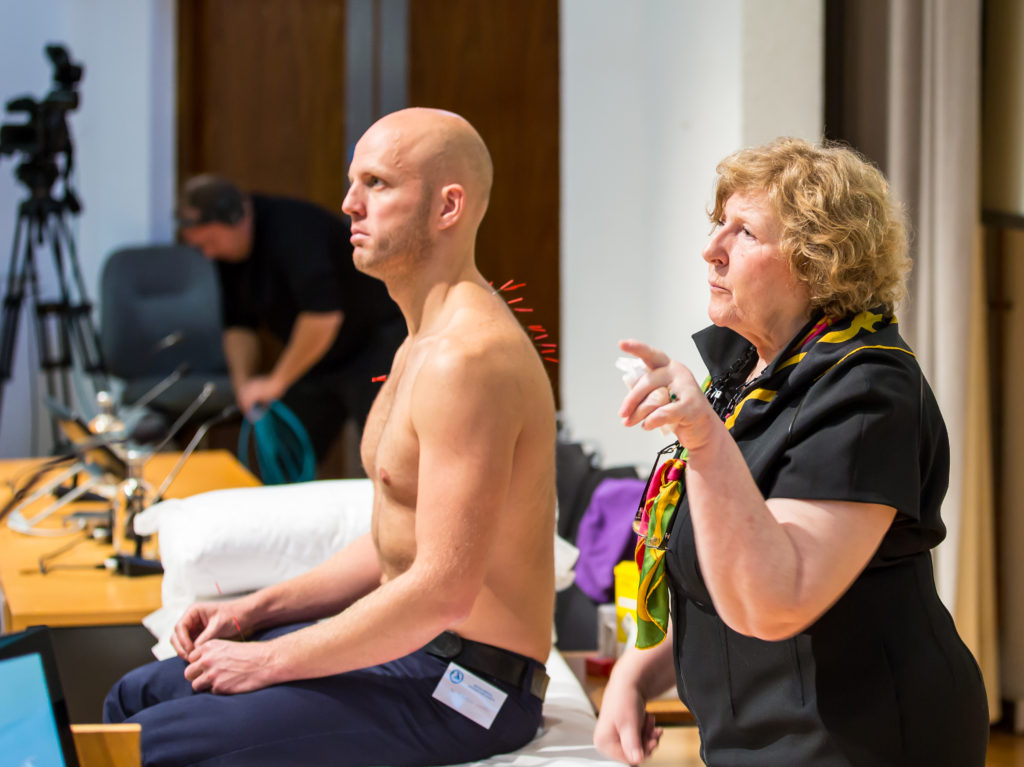…a career-defining symptom?
The Filshie files – breathlessness
 Jacky Filshie (JF) has devoted a medical career to symptom management in the cancer suffering population. Her early personal experience of acupuncture needling had a significant impression on her, probably because she happened to have the right genetic complement to maximise the central effects of the technique. Whatever the reason, she was driven to overcome the scepticism of her colleagues in a very prestigious medical institution, and she began to incorporate acupuncture treatment into her routine practice in the cancer pain population.[1] Her enthusiasm for the technique grew, and soon she was trying it on a variety of the more intractable symptoms of her patients. One of these was acute dyspnoea (breathlessness).[2] A key facet of the technique involved gentle periosteal tapping at two sites in the midline on the manubrium of the patient with 36 gauge acupuncture needles (0.16mm diameter). This technique has come to be known as ASAD, which stands for Anxiety, Sickness, And Dyspnoea, or fondly, to reflect JF’s enthusiasm, All Singing And Dancing. In practice this seems to result in a rapid reduction in anxiety and respiratory rate in at least 50% of patients – the figure comes from a conservative and independent palliative care physician who I asked for an honest and confidential opinion some years ago, because without personal experience of using it I admit to having been a little sceptical of JF’s seemingly miraculous results. In 1996 JF noted a marked symptomatic benefit in 70% of her pilot study population with cancer related breathlessness.
Jacky Filshie (JF) has devoted a medical career to symptom management in the cancer suffering population. Her early personal experience of acupuncture needling had a significant impression on her, probably because she happened to have the right genetic complement to maximise the central effects of the technique. Whatever the reason, she was driven to overcome the scepticism of her colleagues in a very prestigious medical institution, and she began to incorporate acupuncture treatment into her routine practice in the cancer pain population.[1] Her enthusiasm for the technique grew, and soon she was trying it on a variety of the more intractable symptoms of her patients. One of these was acute dyspnoea (breathlessness).[2] A key facet of the technique involved gentle periosteal tapping at two sites in the midline on the manubrium of the patient with 36 gauge acupuncture needles (0.16mm diameter). This technique has come to be known as ASAD, which stands for Anxiety, Sickness, And Dyspnoea, or fondly, to reflect JF’s enthusiasm, All Singing And Dancing. In practice this seems to result in a rapid reduction in anxiety and respiratory rate in at least 50% of patients – the figure comes from a conservative and independent palliative care physician who I asked for an honest and confidential opinion some years ago, because without personal experience of using it I admit to having been a little sceptical of JF’s seemingly miraculous results. In 1996 JF noted a marked symptomatic benefit in 70% of her pilot study population with cancer related breathlessness.
Well it is 20 years on since JF’s first published report, and I am pleased to relate that her observation has been confirmed in a subsequent large pragmatic comparative RCT against and in combination with morphine – the conventional treatment for cancer related breathlessness.[3] In fact the responder rate at 4 hours (primary outcome) in the acupuncture group was 76%, compared with 60% in the morphine group and 66% in the combined group (see Figure 3 below from the trial publication).[3] In statistical terms these were not different, but interestingly there was a highly significant benefit in terms of relaxation (secondary outcome) for acupuncture over morphine.
For those interested, the acupuncture techniques used in the trial are illustrated in the photo below (with thanks to our model Dr Federico Campos): ASAD points; thoracic paraspinals T1 to T5; three trapezius trigger points on each side; and LI4 bilaterally.
You could always come and she her demonstrate in person at the BMAS Palliative Care Day. Or if you are a BMAS member or an academic associate you can watch her in action from the comfort of your own armchair by logging in to watch the webcast of the BMAS Autumn Meeting 2015 held in the Royal College of Physicians, London.
References
1. Filshie J. The non-drug treatment of neuralgic and neuropathic pain of malignancy. Cancer Surv 1988;7:161–93.
2. Filshie J, Penn K, Ashley S, et al. Acupuncture for the relief of cancer-related breathlessness. Palliat Med 1996;10:145–50.
3. Minchom A, Punwani R, Filshie J, et al. A randomised study comparing the effectiveness of acupuncture or morphine versus the combination for the relief of dyspnoea in patients with advanced non-small cell lung cancer and mesothelioma. Eur J Cancer 2016;61:102–10. doi:10.1016/j.ejca.2016.03.078
Declaration of interests
I am the salaried medical director of the British Medical Acupuncture Society (BMAS), a membership organisation and charity established to stimulate and promote the use and scientific understanding of acupuncture as part of the practice of medicine for the public benefit.
I am an associate editor for Acupuncture in Medicine.
I have a very modest private income from lecturing outside the UK, royalties from textbooks and a partnership teaching veterinary surgeons in Western veterinary acupuncture. I have no private income from clinical practice in acupuncture. My income is not directly affected by whether or not I recommend the intervention to patients or colleagues, or by whether or not it is recommended in national guidelines.
I have not chaired any NICE guideline development group with undeclared private income directly associated with the interventions under discussion. I have participated in a NICE GDG as an expert advisor discussing acupuncture.
I have used Western medical acupuncture in clinical practice following a chance observation as a medical officer in the Royal Air Force in 1989. My opinions are formed by data that spans the range of quality and reliability, much of which is in the public domain.
I have a logical mistrust of the motives of anyone who advertises an interest or hobby in being a ‘Skeptic’, as opposed to using appropriate scepticism within their primary profession, or indeed organisations that claim to promote generic ‘science’ as opposed to actually engaging in it.

